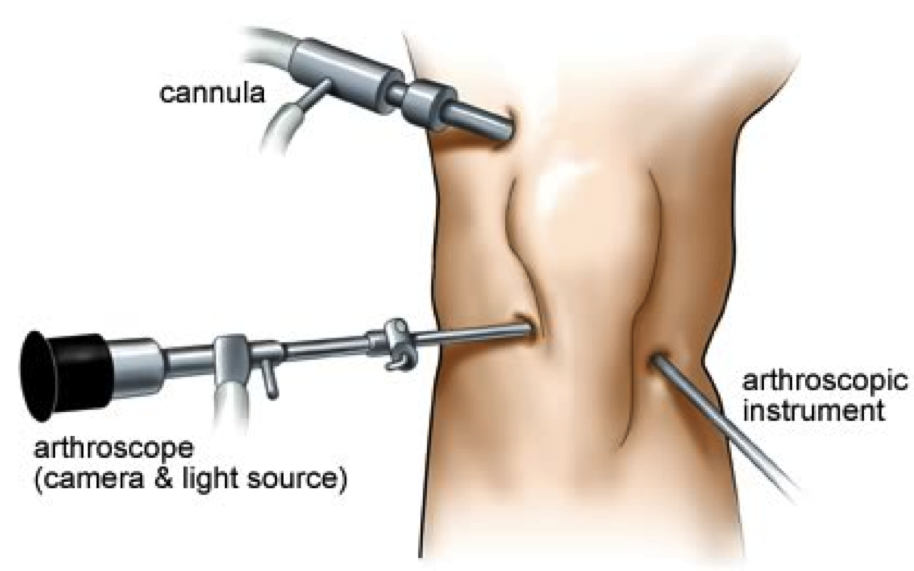Arthroscopy is a surgical procedure doctors use to look at, diagnose, and treat problems inside a joint. Your doctor may recommend it if you have inflammation in a joint, have injured a joint, or have damaged a joint over time. You can have arthroscopy on any joint. Most often, it’s done on the knee, shoulder, elbow, ankle, hip, or wrist. In an arthroscopic examination, an orthopaedic surgeon makes a small incision in the patient’s skin and then inserts pencil-sized instruments that contain a small lens and lighting system to magnify and illuminate the structures inside the joint. Light is transmitted through fiber optics to the end of the arthroscope that is inserted into the joint.
ARTHROSCOPIC SURGERY
Arthroscopic Surgery Overview
By attaching the arthroscope to a miniature television camera, the surgeon is able to see the interior of the joint through this very small incision rather than a large incision needed for surgery.
The television camera attached to the arthroscope displays the image of the joint on a television screen, allowing the surgeon to look, for example, throughout the knee. This lets the surgeon see the cartilage, ligaments, and under the kneecap. The surgeon can determine the amount or type of injury and then repair or correct the problem, if it is necessary.
Why Is Arthroscopy Necessary?
Diagnosing joint injuries and disease begins with a thorough medical history, physical examination, and usually X-rays. Additional tests such as magnetic resonance imaging (MRI) or computed tomography (CT) also scan may be needed.
Through the arthroscope, a final diagnosis is made, which may be more accurate than through “open” surgery or from X-ray studies.
Disease and injuries can damage bones, cartilage, ligaments, muscles, and tendons. Some of the most frequent conditions found during arthroscopic examinations of joints are:
Inflammation
For example, synovitis is an inflammation of the lining in the knee, shoulder, elbow, wrist, or ankle.
Acute or Chronic Injury
- Shoulder: Rotator cuff tendon tears, impingement syndrome, and recurrent dislocations
- Knee: Meniscal (cartilage) tears, chondromalacia (wearing or injury of cartilage cushion), and anterior cruciate ligament tears with instability
- Wrist: Carpal tunnel syndrome
- Loose bodies of bone and/or cartilage: for example, knee, shoulder, elbow, ankle, or wrist
Some problems associated with arthritis also can be treated. Several procedures may combine arthroscopic and standard surgery.
- Rotator cuff surgery
- Repair or resection of torn cartilage (meniscus) from knee or shoulder
- Reconstruction of anterior cruciate ligament in knee
- Removal of inflamed lining (synovium) in knee, shoulder, elbow, wrist, ankle
- Release of carpal tunnel
- Repair of torn ligaments
- Removal of loose bone or cartilage in knee, shoulder, elbow, ankle, wrist.
Although the inside of nearly all joints can be viewed with an arthroscope, six joints are most frequently examined with this instrument. These include the knee, shoulder, elbow, ankle, hip, and wrist. As advances are made in fiberoptic technology and new techniques are developed by orthopaedic surgeons, other joints may be treated more frequently in the future.
Arthroscopic Surgery?
Arthroscopic Surgery isn’t an option for everyone. Talk with our doctor about the benefits and risks of Arthroscopic Surgery and how it compares with other techniques, such as other types of minimally invasive surgery and conventional open surgery.
Why Doctor Lopez?
Doctor Lopez specializes in minimally invasive sports medicine and joint replacement. Dr. Lopez performs a variety of complex procedures in the upper and lower extremities including rotator cuff surgery, knee ligament surgery, and the direct anterior total hip replacement.
Dr. Lopez has had extensive training to meet the needs of his patients. Dr Lopez completed his undergraduate degree in the major of biology at Cornell University. He then went on to graduate from the New Jersey Medical School with his degree in Medicine. Also during that time, Dr. Lopez performed basic science research at the prestigious Whitehead Institute, an affiliate of the Massachusetts Institute of Technology.
Reference: https://www.mayoclinic.org/

